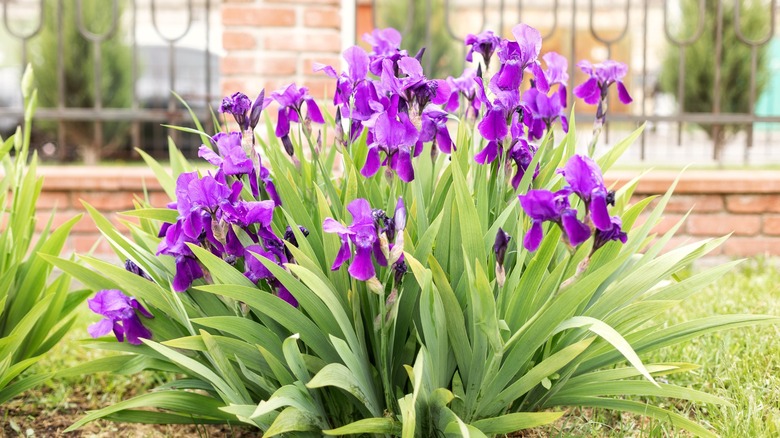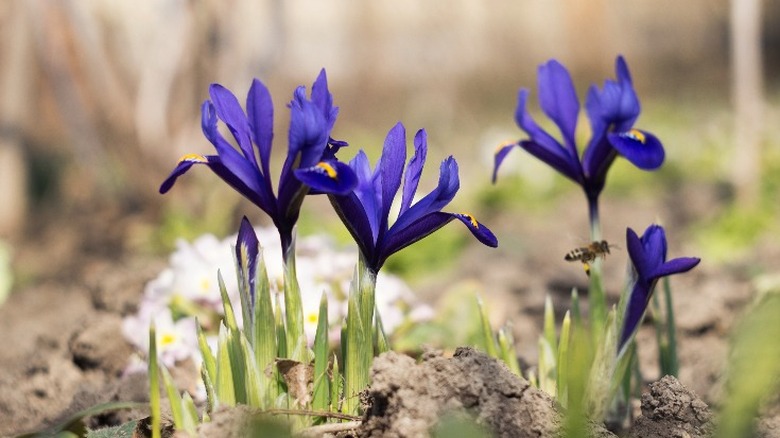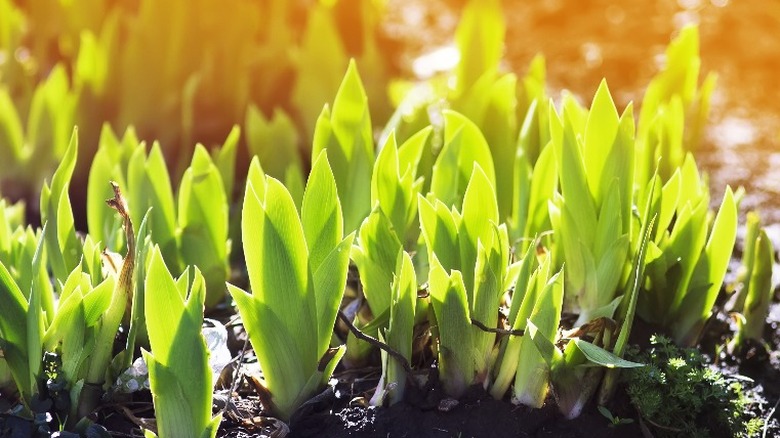The Best Time To Fertilize The Iris In Your Garden
Fertilizing your bulbs is a good practice to ensure healthy plants that continue to flower year after year. However, a gardening mistake you may be making with your bulbs could be related to the timing of fertilization. The iris in your garden requires proper care to grow beautiful flowers with their characteristic flash petals. To learn more about how often to fertilize irises in your garden, we asked author and garden writer Colleen Vanderlinden to provide some tips for best practices. According to her, the best time to fertilize irises is in early spring and then again after they finish blooming, around early to mid-summer.
In an exclusive interview with House Digest, Vanderlinden mentions that while irises don't need a lot of fertilizer, it can be a good way to get stronger blooms. Although she tries to fertilize her irises twice yearly, it's okay to do it once in early spring. She explains her process: "I keep an eye out for the first green shoots poking out of the soil, and I fertilize then. This is a good time to do it because it provides a good boost of nutrients while the plant is preparing to bloom."
Expert fertilizer tips for healthy irises
Picking the right fertilizer for the iris in your garden can be just as important as fertilizing at the right time. Low-nitrogen fertilizer provides the right amount of nutrients, whereas, according to Vanderlinden, high-nitrogen fertilizers lead to "weak growth of lots of leaves, often at the cost of the big, showy flowers we all want when we grow irises." In an exclusive interview with House Digest, Vanderlinden shared her favorite fertilizer for iris flowers — a balanced bulb fertilizer like Bulb-Tone, which goes for $10 per 4-pound bag at Tractor Supply Co. She also suggests bone meal for fertilizer.
Vanderlinden warns us away from common mistakes when fertilizing irises. It is crucial to never apply fertilizer directly to the rhizome. The rhizome of an iris is the thick, underground stem that grows slightly below the ground or right at ground level. "Applying the fertilizer directly on the rhizome can burn or damage it," according to Vanderlinden, "It's better to apply the fertilizer to the soil around the rhizome and gently scratch it into the top layer of soil with a trowel." She also points out that a plant that doesn't get enough water cannot take up nutrients. She suggests keeping the soil moist to ensure that your iris flowers properly benefit from the nutrients in the fertilizer.
Fertilization do's and don'ts
Sometimes, if your iris plants won't flower, you're likely making one of these mistakes, according to our Master Gardener, including fertilization. Vanderlinden exclusively shared with House Digest that "fertilizing at the wrong time won't really harm your plants" if you follow her advice and use a low-nitrogen fertilizer. It's also important to follow fertilizer instructions carefully, depending on the product you have. According to her, too much nitrogen in the fertilizer later in the season harms iris growth. Vanderlinden adds, "You could encourage a lot of soft, late-season growth, which could deplete the nutrient stores in the rhizome and reduce blooms the following year."
Thankfully, she also points out that it can actually be okay to under-fertilize your iris flowers. Her advice is, "When in doubt, leave it out." In the end, if you are excited to learn how to grow and take care of a bearded iris or any other iris type, try not to stress about fertilization. If you plant your irises in good soil, you can still expect lovely blooms each season — even if you forget to fertilize.


